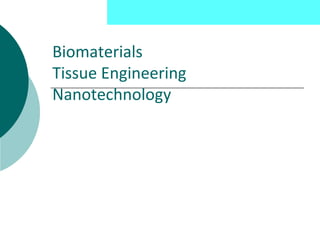
Liu Nanobionics Lab: Tissue Engineering and Biomaterials Research
- 1. Liu Nanobionics Lab Biomaterials Tissue Engineering Nanotechnology
- 2. Biomaterials Biomaterials encompasses aspects of medicine, biology, chemistry, engineering and materials science. Biomaterials are : “Non-viable materials used in a medical devices intended to interact with biological systems” [D.F. Williams, 1987]
- 3. Human Tissue Damage Disease (e.g cancer, infection, degenerative diseaes). Trauma (e.g accidental, surgery). Congenital abnormalities (e.g birth defects). Current clinical treatment based on: Grafts and Transplants Artificial Biomaterials
- 4. Tissue loss as a result of injury or disease, in an increasing ageing population, provides reduced quality of life for many at significant socioeconomic cost. Thus a shift is needed from tissue replacement to tissue regeneration by stimulation the body’s natural regenerative mechanisms.
- 5. Biomaterials: Examples Joint replacements Bone plates Bone cement Hip Joint Artificial ligaments and tendons Dental implants for Heart valve Hip joint tooth fixation Blood vessel prostheses Heart valves Skin repair devices Cochlear replacements Knee joint Skin Contact lenses
- 6. Biomaterials Prostheses have significantly improved the quality of life for many ( Joint replacement, Cartilage meniscal repair, Large diameter blood vessels, dental) However, incompatibility due to elastic mismatch leads to biomaterials failure.
- 7. Tissue Engineering National Science Foundation first defined tissue engineering in 1987 as “ an interdisciplinary field that applies the principles of engineering and the life sciences towards the development of biological substitutes that restore, maintain or improve tissue function”
- 8. Tissue engineering Potential advantages: unlimited supply no rejection issues cost-effective
- 9. Tissue Engineering Expand number in culture Remove cells from the body. Seed onto an appropriate scaffold with suitable growth factors and cytokines Re-implant engineered tissue repair damaged site Place into culture
- 10. SCAFFOLDS
- 11. Synthetic polymers More controllable from a compositional and materials processing viewpoint. Scaffold architecture are widely recognized as important parameters when designing a scaffold They may not be recognized by cells due to the absence of biological signals.
- 12. Natural polymers Natural materials are readily recognized by cells. Interactions between cells and biological materials are catalysts to many critical functions in tissues These materials have poor mechanical properties.
- 19. Tissue engineering scaffold: Self-assembly Self-aggregation of hydrophilic, lipophilic groups First layer creates template for growth of second layer Ions can be deposited on charged sites This kind of self- aggregation leads to ordered, heirarchical structures
- 21. Tissue engineering scaffold: controlled architecture Featured with: Pre-defined channels; with highly porous structured matrix; With suitable chemistry for tissue growth – Collagen or HA No toxic solvent involved, it offers a strong potential to integrate cells/growth factors with the scaffold fabrication process.
- 22. Architecture of Hard Tissue Staggered mineral platelets (hydroxyapataite) embedded in a collagen matrix Arrangement of platelets in preferred orientations makes biocomposites intrinsically anisotropic Under an applied tensile stress, the mineral platelets carry most of the tensile load Protein matrix transfers the load between mineral crystals via shear Biocomposites can be described through tension-shear model described by Ji et. al.
- 23. Tissue engineering scaffold: Electrospinning This process involves the ejection of a charged polymer fluid onto an oppositely charged surface. Multiple polymers can be combined Control over fiber diameter and scaffold architecture
- 24. Printing Techniques for Tissue Engineering
- 25. Techniques to study scaffolds: Scanning Probe Microscopy Atomic Force Microscopy :Surface irregularities Scanning Tunneling Microscopy: Conducting Surfaces Adhesion Force Microscopy: Functionalised tips
- 26. Surface Modification of Biomaterials
- 27. Enhanced intrinsic biomechanical properties of osteoblastic mineralized tissue on roughened titanium surface Nano-indentation Acid-etched vs. Machined surfaces culturing osteoblasts on rougher titanium surfaces enhances hardness and elastic modulus of the mineralized tissue
- 28. Surface modification of SPU Segmented Polyurethane – common biocompatible elastomer 2-methacryloyloxyethyl phosphorylcholine added to create nano-domains on surface Nano-scale domains reduce platelet adhesion to biomaterial surface Nano-scale surface modification of a segmented polyurethane with a phospholipid polymer, Biomaterials 25 (2004) 5353–5361
- 30. Immunoisolation for Cell-encapsulation therapy Liver Dysfunction: Encapsulation of Hepatic Cells Pancreas Dysfunction: Encapsulation of Islets of Langerham Disorders of the CNS: Parkinson’s, Alzheimer’s Pre-requisites for cell encapsulation continued and optimal tissue/cell supply maintenance of cell viability and function successful prevention of immune rejection Nanoporous Silicone-based biocapsules serves as Artificial Pancreas(Desai et al. 2001) What are the drawbacks of such an artificial pancreas?
- 31. Nanoengineering Bio-analogous Structures Bone-cartilage composite ? Muscle ? Brain-machine Interface ?
- 32. An Ink-Jet Printer for Tissue Engineering?
